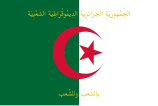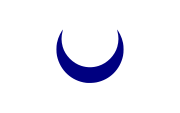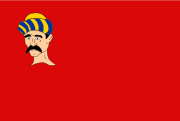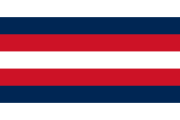Flag of Algeria
 | |
| Use | National flag, civil and state ensign |
|---|---|
| Proportion | 2:3 |
| Adopted | 3 July 1962 |
| Design | A vertical bicolor of green and white, with the red crescent encircling the red five-pointed star centered along the dividing line. |
 | |
| Use | Presidential standard |
| Proportion | 2:3 |
 | |
| Use | Naval ensign |
| Proportion | 2:3 |
| Adopted | 27 June 1963 (amended in 1995) |
| Design | As above, with white crossed fouled anchors in the canton. |
 | |
| Use | Naval jack |
| Design | The national flag in the canton on a light blue field. |
The national flag of Algeria (علم الجزائر) consists of two equal vertical bars, green and white, charged in the center with a red star and crescent, a symbol of Islam as the nation's prominent faith. The flag was adopted on 3 July 1962. A similar version was used by the Algerian government in exile from 1958 to 1962. The Western blazon is per pale vert and argent; a crescent and star gules.
Description
[edit]Algerian ships fly it as their ensign, except for ships of the Algerian National Navy, which use one charged with two white crossed anchors in the canton as the naval ensign. Formerly, the two crossed anchors in the canton were red.
According to algeria-un.org, cited in 1999, the features of the flag are set down precisely, being described as:
The green must be a composition of equal yellow and blue having, according to the diagram of contrasts of Rood, a wavelength of 5,411 [ångströms] and the position 600 on the normal spectrum. The red must be pure, of primary non-decomposable colour, and exempt of blue and yellow having, according to the above-indicated diagram, a wavelength of 6,562 [ångströms] and the position 285 on the normal spectrum.[1]
Colours scheme |
Red | Green | White |
|---|---|---|---|
| RGB | 210-16-52 | 0-102-51 | 255-255-255 |
| Hexadecimal | #D21034 | #006633 | #FFFFFF |
| CMYK | 0, 92, 75, 18 | 100, 0, 50, 60 | 0, 0, 0, 0 |
| Pantone | 186 C | 356 C | White |
Construction Sheet
[edit]Symbolism
[edit]The flag aims to highlight Algeria's cultural heritage, but there are different interpretations of its elements. According to Malek Chebel, green represents Islam and white represents purity.[2] For Pierre Lux-Wurm, green and white bring to mind the ancient banners of Islam from the time of the Prophet Muhammad, while the crescent and star can be seen as symbols of light.[3] According to Khaled Merzouk, the green stripe represents the earth and agriculture, the white stripe represents peace and the crescent and star are symbols of Islam.[4] The star represents the five pillars of Islam.[5] Benjamin Stora suggests that the three colors of the flag originally represented the three countries of the Maghreb and the ideas of union.[6]
History
[edit]Middle Ages
[edit]In the Middle Ages, various Islamic dynasties ruled in what is now Algeria and controlled different territories at different times. At that time, national flags as we understand them today were not used. It is possible to distinguish, using various sources, certain constants, such as the presence of a crescent with variable orientation and the presence of the colors red, blue and white.[7]
-
Flag of Kingdom of Tlemcen on according to the Portolan chart.
-
Flag of Kingdom of Tlemcen on Pietro Vescontes' map.
Regency of Algiers
[edit]Red, yellow and green flags
[edit]Numerous Arab and French sources unanimously agree on the tricolor Algerian flag of red, green and yellow horizontal bands, raised first by the corsair then Sultan Oruç Barbarossa,[8][9][10] the founder of the Regency of Algiers, a tributary state of the Ottoman Empire in North Africa from 1516 to 1830.[11] The tricolor flag seemed to be raised on the main gate of Bab Azzoun in Algiers,[12] as well as the Djenina palace,[13] forts and other governmental buildings in Algiers, the flag also accompanied the forces of the regency in notable battles like the Algiers expedition of 1541 and the siege of Malta.[14] It was called "the victorious flag" according to an arab manuscript,[15] while some French authors branded it as "insolent" and "terrible".[16][17] It was even described by other authors as "the national flag of Algiers".[18][19] One variant was considered a War flag according to Bertrand Dubreuil.
Ottoman regent's flags
[edit]-
Flag of the Beylerbey-Pasha-Dey of Algiers
-
Flag of the Dey of Algiers according to the album by John Beaumont (1705).[20]
-
Flag of the Beylerbey of Algiers in Kurtoğlu, Fevzi (1987). Türk bayrağı ve ay yıldız (in Turkish). Türk Tarih Kurumu.
-
Old Dutch engraving. "De Stad Haven En Mouillie Van Algiers Neven Desselfs Kasteelen" (the city, the port and the pier of Algiers) circa 1690
Military flags
[edit]Naval flags
[edit]-
Pavilion of the Regency of Algiers (17th-18th centuries)[25]
-
A pavilion of the regency of Algiers[26]
-
Example of a flag used by corsairs of the Algiers regency.[24]
-
Pavilion of the Regency of Algiers.[24]
-
A Sea Fight with Barbary Corsairs by Laureys a Castro, c. 1681. Note the various flags with crescents used by the pirates.
The Barbary pirates of Ottoman Algeria between the 15th and 17th century widely used flags that were emblazoned with one or more crescents. These could however vary greatly in color, with dark red, black, green and white being in use. Besides these, Algerian pirates also used various flags in plain color, such as plain black ones signalling death. Less often, Algerian flags of this time also carried other motifs, such as suns, stars and crossed swords.[28] It is also known that city of Algiers used an orange flag with a white horizontal sword on it by the early 19th century.[29]
French Algeria
[edit]-
Flag used by France in Algeria when as a colony and later a part of France
French Algeria was the period of Algerian history when the country was a colony and later a part of France, for this reason the official flag was the flag of France. The French invasion began at a time when France used a solid white flag, but during the campaign, as a result of the July Revolution in metropolitan France, the tricolor was adopted, which remained in use until the independence of the Republic of Algeria in 1962. In the 19th century there was a merchant flag used on ships coming from Algeria and it was adopted after 1848, when the territories in Algeria were integrated with Metropolitan France, creates the multicolored motifs of the striped flags of the regency. The exact rules and years of use of the striped flag are unknown. The misrepresentation of the merchant flag as the main flag of French Algeria has been happening since the 19th century.[30]
Emirate of Abdelkader
[edit]-
Flag of the Emirate of Abdelkader (1832–1847)
-
Regimental flag
-
Flag captured by the French
The Emirate of Abdelkader or Emirate of Mascara was a sovereign country founded by Abdelkader al-Jazairi with the allegiance of the people of Algeria to resist the French conquest of Algeria with its first capital at Mascara then Tagdemt after it was taken by France.[31] Many flags were used in the emirate, but the most important is the green and white one used at Abdelkader's tent.[clarification needed] In the white center was a raised hand of Fatima drawn surrounded by the words in gold "victory from Allah and the reconquest is near, and the victory by Emir Abdelkader". Copies of this flag, although different in proportions, are kept in the Emir Abdelkader Museum in Miliana[32]
History of the current flag
[edit]-
One of the flags used in Sétif revolt (1945)
-
Flag of Algerian nationalists from Democratic Union of the Algerian Manifesto.
-
One of many variants of the flag used by Algierian nationalists before gaining independence.
-
One of many variants of the flag used by Algierian nationalists before gaining independence.
The North African Star (ENA) Association was preserved in 1926, with Messali Hadj as its chairman, and one of its members was the grandson of the Emir Abdelkader, Khalid ibn Hashim. Since 1926, this organization has used a green flag with the words "Algeria our country, Arabic our language and Islam our religion".[34]
While there is some dispute over who exactly designed the green and white with red star and crescent symbol,[35] Émilie Busquant, wife of the Algerian nationalist leader Messali Hadj, is generally credited as having sewed the first version of the flag in 1934.[36]
Historian Benjamin Stora explains that it was during a meeting of the ENA, in 1934, that the colors of the flag were chosen, after which Émilie Busquant was tasked with sewing it.[37] However, René Gallissot and Anissa Bouayed affirm that this is not the first appearance of the Algerian flag, as Algerian trade union demonstrators displayed this same flag (green and white with a red star and crescent) during the May Day parades in 1919 and 1920, in France and Algeria.[38][39]

Research by historian Mohamed Ghnanèche shows that in 1940, another flag was adopted with a red star and a white crescent placed above the center. It was then transformed by the Algerian People's Party (PPA) to its current form in 1943. According to Achour Cheurfi, the design of the current flag comes from PPA independence activists who, around 1944, commissioned a limited group to select the flag, it will be raised for the first time during demonstration in Sétif.[40] During these events, this is carried, among others, by Bouzid Saâl, a student who will later be killed by the French police.[41]
The green and white flag marked with a star and a red crescent was adopted by the National Liberation Front (FLN), which led the fight against France and was subsequently adopted in 1958 by the Provisional Government of the Algerian Republic. It was raised at the Monrovia Conference in August 1959, where it was officially recognized by several African countries. It is then formalized and standardized by the law of April 25, 1963.[42]
Unicode
[edit]The flag of Algeria is represented as the Unicode emoji sequence U+1F1E9 🇩 REGIONAL INDICATOR SYMBOL LETTER D and U+1F1FF 🇿 REGIONAL INDICATOR SYMBOL LETTER Z, making "🇩🇿".[43]
See also
[edit]References
[edit]- ^ "Thanh-Tâm Lê, 2 January 1999 (crwflags.com)". 1999. Archived from the original on 2013-01-07. Retrieved 2016-06-15.
- ^ Chebel 2001, p. 143
- ^ Lux-Wurm 2001, p. 38
- ^ "The Flag of Algeria". flagdb.com. Retrieved 2024-09-19.
- ^ Merzouk 2008, p. 253
- ^ Stora, Benjamin (1985). Dictionnaire biographique de militants nationalistes algériens (in French). p. 74.
- ^ (in Arabic) Drapeaux des Hafsides souverain de Tunis et Béjaïa Archived 2024-03-23 at the Wayback Machine
- ^ توفيق, مدني، أحمد (1984). حرب الثلاثمائة سنة بين الجزائر واسبانيا، 1492-1792 (in Arabic). المؤسسة الوطنية للكتاب،. p. 175. Archived from the original on 2024-04-17. Retrieved 2024-01-28.
- ^ Garrot, Henri (1910). Histoire générale de l'Algérie (in French). Impr. P. Crescenzo. p. 360. Archived from the original on 2023-07-08. Retrieved 2024-01-28.
- ^ Tarek Kahlaoui (2018). Creating the Mediterranean Maps and the Islamic Imagination. Brill. p. 216. ISBN 9789004347380. Archived from the original on 2024-04-17. Retrieved 2024-01-28.
- ^ McDougall, James, ed. (2017), "Ecologies, Societies, Cultures and the State, 1516–1830", A History of Algeria, Cambridge: Cambridge University Press, pp. 9–48, doi:10.1017/9781139029230.003, ISBN 978-0-521-85164-0, archived from the original on 2023-09-03, retrieved 2023-09-14
- ^ Gaïd, Mouloud (1975). L'Algérie sous les Turcs (in French). Maison tunisienne de l'édition. p. 58.
The great flag of Algiers, formed of three bands of silk in red, green and yellow, majestically deployed over the gate
- ^ Fondation de la régence d'Alger: histoire des Barberousse, chronique arabe du XVIe siècle, publiée sur un manuscrit de la Bibliothèque royale, avec un appendice et des notes : expédition de Charles-Quint (in French). Bouslama. 1837. p. 193. Archived from the original on 2024-04-17. Retrieved 2024-01-28.
it was from the top of its vast terraces (Jenina palace) on which floated the red, yellow and green standard
- ^ Drohojowska.]), A. S. de DONCOURT (Chevalier, pseud [i e the Countess Antoinette Joséphine Fránçoise Anne (1875). Les Fastes de la Marine Française. Marine militaire (in French). Archived from the original on 2024-04-17. Retrieved 2024-01-28.
{{cite book}}: CS1 maint: multiple names: authors list (link) - ^ Farine, Charles (1869). Deux pirates au XVIe siècle: histoire des Barberousse (in French). P. Ducrocq. p. 501. Archived from the original on 2024-04-17. Retrieved 2024-01-28.
- ^ Marius Bernard (1887). L'Algérie qui s'en va (in French). Plon, Nourrit. p. 39.
- ^ DROHOJOWSKA, Countess Antoinette Joséphine Françoise Anne (1848). L'historie d'Algérie, racontée à la jeunesse ... ouvrage ... précédé d'une préface de D. Lévi Alvarès ... et faisant suite au cours d'histoires racontées á la jeunesse ... par M. Lamé Fleury (in French). Archived from the original on 2024-04-17. Retrieved 2024-01-28.
- ^ Léon Galibert (1844). ancienne et moderne depuis les premiers éstablissements des Carthaginois jusqu'à la prise de la Smalah d'Abd-el-Kader (in French). Furne. p. 181. Archived from the original on 2024-04-17. Retrieved 2024-01-28.
- ^ مولود قاسم نايت بلقاسم (1985). شخصية الجزائر الدولية وهيبتها العالم العالمية قبل سنة ١٨٣٠, Volume 1 (in Arabic). دار البعث. p. 142. Archived from the original on 2024-04-17. Retrieved 2024-01-28.
- ^ a b Pierre Lux-Wurm (2001). Les drapeaux de l'islam. Buchet-Chastel. ISBN 978-2-283-01813-2.
- ^ Flag Bulletin. Flag Research Center. 1986. p. 166. Archived from the original on 2024-04-17. Retrieved 2024-01-28.
- ^ "Algeria: Miscellaneous flag reports, late 18th - early 19th century". Archived from the original on 2023-12-10. Retrieved 2024-01-01.
- ^ B. Dubreuil, Les pavillons des États musulmans, Publications de la Faculté des lettres et des sciences humaines de Rabat, 1965, p. 11
- ^ a b c d Carington Bowles (1783). Bowles's universal display of the naval flags of all nations in the world. Londres. Archived from the original on 2023-11-13. Retrieved 2024-01-01.
- ^ B. Dubreuil, Les pavillons des États musulmans, Publications de la Faculté des lettres et des sciences humaines de Rabat, 1965, p. 11.
- ^ B. Dubreuil, Les pavillons des États musulmans, Publications de la Faculté des lettres et des sciences humaines de Rabat, 1965, p. 11.
- ^ "AL DJAZAIR Algeria". Archived from the original on 2014-07-14. Retrieved 2015-01-23.
- ^ Konstam (2016), pp. 34–37, 40, 43, 52, 56, 57 61.
- ^ Konstam (2016), p. 61.
- ^ "Cigarette Cards: Flag Girls (1908)". www.listal.com. Archived from the original on 2022-07-15. Retrieved 2022-05-04.
- ^ Sedgwick, Mark (2016-10-18). Western Sufism: From the Abbasids to the New Age. Oxford University Press. ISBN 978-0-19-997766-6.
- ^ "Le sel de la terre: Passage à la manufacture d'armes de l'Emir Abdelkader à Miliana". 13 November 2016. Archived from the original on 26 December 2023. Retrieved 1 January 2024.
- ^ Carréras, Fernand (1967). L'accord FLN-OAS, des négociations secrètes au cessez-le-feu (in French). p. 102.
- ^ Sadouni, Brahim (1990). Le drapeau: écrit d'un harki. L'Harmattan. p. 68.
- ^ Houda, B. (20 August 1997). "Le vert, le blanc, l'étoile et le croissant Qui a conçu le drapeau algérien ?". El Watan. Archived from the original on 13 March 2012. Retrieved 28 February 2017.
- ^ Kessous, Mustapha. "Emilie Busquant la plus algerienne des francaises". Archived from the original on 2022-11-18. Retrieved 2022-12-17.
- ^ Benjamin Stora, Nationalistes algériens et révolutionnaires français au temps du Front populaire, L'Harmattan, 1987, p. 94, extrait en ligne Archived 2023-10-08 at the Wayback Machine.
- ^ René Gallissot; Anissa Bouayed (2006). Algérie. Engagements sociaux et question nationale : de la colonisation à l'indépendance de 1830 à 1962. Éditions de l'Atelier. p. 176.
- ^ Gallissot, René (December 30, 2004). "Deux notices du Dictionnaire biographique du mouvement ouvrier-Algérie". Insaniyat / إنسانيات. Revue algérienne d'anthropologie et de sciences sociales. 25–26 (25–26): 143–158. doi:10.4000/insaniyat.6325. ISSN 1111-2050. Archived from the original on December 17, 2022. Retrieved December 17, 2022.
- ^ Cheurfi 2004, p. 144
- ^ Achour Cheurfi, La révolution algérienne (1954-1962) : Dictionnaire biographique, Casbah éditions, 2004, 495 p. (ISBN 978-9961-64-478-2)
- ^ "Repères chronologiques de la guerre d'Algérie". Archived from the original on 2011-01-12. Retrieved 2024-01-01.
- ^ "🇩🇿 Flag for Algeria Emoji". Retrieved 19 December 2024.
Bibliography
[edit]- Chebel, Malek (2001). Dictionnaire des symboles musulmans. Éditions Albin Michel.
- Cheurfi, Achour (2004). La révolution algérienne (1954-1962): Dictionnaire biographique (in French). Casbah éditions. ISBN 978-9961-64-478-2.
- Konstam, Angus (2016). The Barbary Pirates. 15th–17th Centuries. Oxford: Osprey Publishing. ISBN 978-1-4728-1543-9.
- Lux-Wurm, Pierre (2001). Les drapeaux de l'islam (in French). Buchet-Chastel. ISBN 978-2-283-01813-2.
- Merzouk, Khaled (2008). Messali Hadj et ses compagnons a Tlemecen : récits et anecdotes de son époque, 1898-1974 (in French). El Dar El Othmania.
External links
[edit]![]() Media related to Flags of Algeria at Wikimedia Commons
Media related to Flags of Algeria at Wikimedia Commons
- Algeria at Flags of the World
- Flag of Algeria at flagscorner.com Archived 2019-12-12 at the Wayback Machine









![Flag of the Dey of Algiers according to the album by John Beaumont (1705).[20]](http://up.wiki.x.io/wikipedia/commons/thumb/a/a9/Pavillon_du_day_d%27Alger_%28XVIII_-_XIX_siecle%29.svg/172px-Pavillon_du_day_d%27Alger_%28XVIII_-_XIX_siecle%29.svg.png)


![Algerian Land forces Flag (Odjak of Algiers), during the conquest, the French captured about 100 with varying numbers of red and yellow stripes. [21][22]](http://up.wiki.x.io/wikipedia/commons/thumb/e/e7/Flag_of_Algerian_Land_forces_%28Odjak_of_Algiers%29.svg/180px-Flag_of_Algerian_Land_forces_%28Odjak_of_Algiers%29.svg.png)

![War flag of Algiers[23]](http://up.wiki.x.io/wikipedia/commons/thumb/9/94/Type_d%27%C3%A9tendard_de_gierre_%28XVIII_siecle%29.svg/180px-Type_d%27%C3%A9tendard_de_gierre_%28XVIII_siecle%29.svg.png)
![One of the types of merchant flags of Regency of Algiers.[20][24]](http://up.wiki.x.io/wikipedia/commons/thumb/2/24/Type_de_pavillon_maritime_%28XVI_-_XVIII_siecle%29.svg/158px-Type_de_pavillon_maritime_%28XVI_-_XVIII_siecle%29.svg.png)
![Pavilion of the Regency of Algiers (17th-18th centuries)[25]](http://up.wiki.x.io/wikipedia/commons/thumb/2/26/Pavillon_de_la_R%C3%A9gence_d%27Alger_%28XVIIe-XVIIIe_si%C3%A8cles%29_A6.svg/180px-Pavillon_de_la_R%C3%A9gence_d%27Alger_%28XVIIe-XVIIIe_si%C3%A8cles%29_A6.svg.png)
![A pavilion of the regency of Algiers[26]](http://up.wiki.x.io/wikipedia/commons/thumb/3/36/Pavillon_de_la_R%C3%A9gence_d%27Alger_%28XVIIe-XVIIIe_si%C3%A8cles%29_A8.svg/158px-Pavillon_de_la_R%C3%A9gence_d%27Alger_%28XVIIe-XVIIIe_si%C3%A8cles%29_A8.svg.png)
![Flag of the official in charge of the fleet.[27][24]](http://up.wiki.x.io/wikipedia/commons/thumb/0/09/Lesser_coat_of_arms_of_Regency_of_Algiers.svg/120px-Lesser_coat_of_arms_of_Regency_of_Algiers.svg.png)
![Example of a flag used by corsairs of the Algiers regency.[24]](http://up.wiki.x.io/wikipedia/commons/thumb/3/32/Pavillon_de_la_R%C3%A9gence_d%27Alger_%28XVIIe-XVIIIe_si%C3%A8cles%29_A3.svg/180px-Pavillon_de_la_R%C3%A9gence_d%27Alger_%28XVIIe-XVIIIe_si%C3%A8cles%29_A3.svg.png)
![Pavilion of the Regency of Algiers.[24]](http://up.wiki.x.io/wikipedia/commons/thumb/b/b6/Pavillon_de_la_R%C3%A9gence_d%27Alger_%28XVIIe-XVIIIe_si%C3%A8cles%29_A4.svg/172px-Pavillon_de_la_R%C3%A9gence_d%27Alger_%28XVIIe-XVIIIe_si%C3%A8cles%29_A4.svg.png)













![Flag proposed during ceasefire talks between FLN and OAS representatives in Algiers during Summer 1962.[33]](http://up.wiki.x.io/wikipedia/commons/thumb/a/a8/Proposed_Flag_of_Algeria_during_FLN-OAS_ceasefire_talks_%281962%29.svg/180px-Proposed_Flag_of_Algeria_during_FLN-OAS_ceasefire_talks_%281962%29.svg.png)
